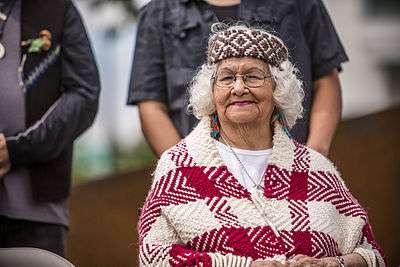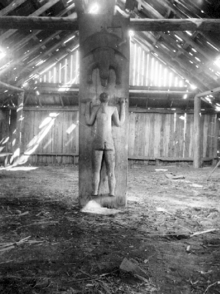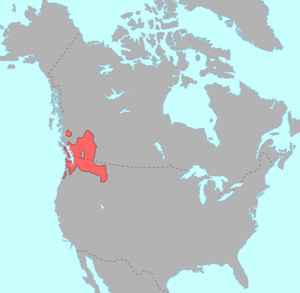Salish peoples
The Salish peoples are an ethno-linguistic group of the Pacific Northwest of the US and SW Canada, identified by their use of the Salish languages which diversified out of Proto-Salish between 3,000 and 6,000 years ago.
Séliš | |
|---|---|
 | |
| Regions with significant populations | |
| British Columbia, Washington, Oregon, Idaho, Montana | |
| Languages | |
| Salishan languages | |
| Related ethnic groups | |
| Indigenous peoples of the Pacific Northwest Coast |
The term “Salish” originated in the modern era as an exonym created for linguistic research. Salish is an anglicization of Séliš, the endonym for the Salish Tribes of the Flathead Reservation. The Séliš were the easternmost Salish people and the first to have a diplomatic relationship with the United States so their name was applied broadly to all peoples speaking a related language.
Salish language
The Salish (or Salishan) people are in four major groups: Bella Coola (Nuxalk), Coast Salish, Interior Salish, and Tsamosan, who each speak one of the Salishan languages. The Tsamosan group is usually considered a subset of the broader Coast Salish peoples.
Among the four major groups of the Salish people, there are twenty-three documented languages. At least five of these are no longer in use, while the rest of them are seriously endangered. The majority of fluent Salish-speakers are elderly, and younger speakers are quite rare. In spite of this, there are ongoing efforts to keep the languages alive though revitalization programs planned and conducted by various tribal organisations. Currently, a team of scholars is conducting research on the languages in order to create reference material and educational resources.[1][2]
Salish languages, especially those of the Coast peoples, are threatened primarily by assimilation. State programs such as the Canadian residential schools (where indigenous languages were prohibited) have been a major factor in reducing the number of fluent Salish speakers. Schools today, however, from the secondary to the university level, are actively promoting knowledge and use of the Salish languages.[3]
Language and cultural revitalization
In 1988, the Self Governance Demonstration Project of the Confederated Salish and Kootenai Tribes (the CSKT) was successful, and the U.S. government returned full autonomy to their tribal leadership in 1993. Over the following decades the CSKT has reverted to traditional governance in which Elders provide counsel, to the chief, on tribal policies, culture and education, and in turn tribal policies have grown out of a desire to strengthen the community’s ties to their cultural heritage.[4]
In a move to self-identify and push back against the effects of the Indian Termination policy, namely assimilation, in 2016 the tribe chose to change their name from the anglicized “Salish-Prend d’Oreille” to Séliš-Ql̓ispé. The change was part of a wider movement to include more Salishan in the daily lives of the community.
For the Séliš-Ql̓ispé, language and culture are entwined — through oral histories, food practices, horticulture, environment, and spirituality. By reviving the language, they hope to also reclaim their identity, their health, and their culture.[5]
Community efforts to revitalize the Salishan language and culture, aside from efforts to teach classes on language (in some cases, full-immersion into the language with no falling back onto English), include such things as virtual tours and museums, such as the Sq'éwlets, which is a Stó:lō-Coast Salish Community in the Fraser River Valley.[6] There is also the People's Center Museum[7] that opened in 1994 and hosts a rotating exhibition of Salish and Kootenai cultural artifacts. The museum is supplemented with an oral tradition of story-telling that explains the significance of the pieces on display, and shares the stories of the people who lived in the time before and during the European invasion.[7]
There have also been calls for repatriation of artifacts across all indigenous tribes of the Americas as additional efforts to reclaim history and culture.
Powwows
The Arlee Espapqeyni Celebration is a yearly 4 July powwow hosted by the Confederated Salish and Kootenai Tribes and is located in Arlee, Montana. It runs for a period of several days and involves dance competitions and singing competitions (and non-competitive singing and drum performances).[8]
In 1884 the BIA (Bureau of Indian Affairs) made it illegal for any Indian dances to be performed, and so the tribes danced in secret.[8] A new, religiously-influenced dance called the Ghost Dance began spreading from tribe to tribe at a rate that the U.S. government was wary of, and in 1890 a military unit was dispatched to Wounded Knee to interrupt a ceremony of the Ghost Dance among the Sioux. Roughly 200 Sioux were gunned down in what is now known as the Wounded Knee Massacre.
Modern powwows came about after the armistice of World War 1, when Native American veterans returned home from war; celebrations were held for their homecoming and included traditional dances. A new sense of community also came into being with the end of the war, along with the proximity of reservations to one another, and the celebrations began to include neighboring tribes rather than remain exclusive to individual tribes.[9]
When Plains Indians were resettled in urban areas following World War II, per the policy of the U.S. government, their culture and traditions went with them and became widely spread—which is why many powwow dances and songs are from the Plains tradition. This dispersal of people and culture into large community centers also tightened the inter-tribal networks that had come into existence after the first World War.[9]
Tours
Water People Tours offer historical and cultural tours specific to Kootenai life, and in-depth and personal insights from tour guides whom are themselves Kootenai—who can pass on the tradition of oral history and significance of places to those who take the tours.[10]
Art and material culture
Salish weaving
Salish weavers used both plant and animal fibers. Coast Salish peoples kept flocks of woolly dogs, bred for their wool, to shear and spin the fibers into yarn. The Coast Salish would also use mountain goat wool, waterfowl down, and various plant fibers including cedar bark, nettle fiber, milkweed and hemp. They would combine these materials in their weaving. A type of white clay was pounded into the fibers, possibly for the purpose of extracting oil from the wool.[11] Not all Salish blankets were made with dog's wool—commoners' blankets were usually made of plant fibers. The designs of Salish weavings commonly featured graphical patterns such as zig-zag, diamond shapes, squares, rectangles, V-shapes and chevrons.[12][13]
In the early to mid nineteenth century, the fur trade brought Hudson's Bay blankets to the Pacific Northwest. The influx of these cheaper, machine-made blankets led to the decline of native wool blankets that were expensive and labor-intensive to produce. Salish weaving continued to a lesser extent, but the weavers largely transitioned to using sheep's wool yarn brought to the area by traders, as it was less costly than keeping the salmon-eating woolly dogs.[14]
There was a revival of Salish weaving in the 1960s, and the Salish Weavers Guild was formed in 1971.[15]
.jpg)
Use of cedar
Plentiful in the Pacific Northwest, the Western Red Cedar was a vital resource in Coast Salish peoples' lives. Canoes, longhouses, totem poles, baskets, mats, clothing, and more were all made using cedar.
Totem poles
Totem poles were less common in Coast Salish culture than with neighboring non-Salish Pacific Northwest Coast peoples such as the Haida, Tsimshian, Tlingit, and Kwakiutl tribes. It wasn’t until the twentieth century that the totem pole tradition was adopted by the northern Coast Salish peoples including the Cowichan, Comox, Pentlatch, Musqueam, and Lummi tribes. These tribes created fewer free-standing totem poles, but are known for carving house posts in the interior and exterior of longhouses.[16][17][18][19]
 Musqueam interior house post
Musqueam interior house post Musqueam exterior house posts
Musqueam exterior house posts Cowichan housefront with carved house posts
Cowichan housefront with carved house posts Salish wooden carvings at The Field Museum, Chicago
Salish wooden carvings at The Field Museum, Chicago Totem pole by Lummi carver Joe Hillaire, 1962
Totem pole by Lummi carver Joe Hillaire, 1962 "Musqueam welcome figures" by Susan A. Point in the International Arrivals hall of Vancouver International Airport
"Musqueam welcome figures" by Susan A. Point in the International Arrivals hall of Vancouver International Airport
Salish peoples located in the Pacific Northwest and parts of Southern Alaska were known to build totem poles that were meant to symbolize a tribe member's spirit animal or family crest. They continue on this legacy today by selling hand carved totem poles formed in the same fashion.[20]
Contemporary Salish artists
- Susan A. Point is a Musqueam wood carver and glass artist. Her work "Musqueam Welcome Figures", inspired by Coast Salish house posts, is featured in the Vancouver International Airport.
- Matika Wilbur is a Swinomish and Tulalip photographer, and the creator of Project 562, which documents contemporary Native Americans from the 562 federally-recognized tribes in the United States.[21]
- Debra Sparrow is a Musqueam artist and weaver. Her weaving was featured in The Fabric of Our Land: Salish Weaving exhibit at the Museum of Anthropology in 2017-2018.[22]
- Corwin Clairmont is a Salish Kootenai printmaker, and a conceptual and installation artist.
Subgroups and territory

Salish people groups are subdivided by their respective branches of the Salishan language family: Coast Salish (peoples) speaking the Coast Salish languages, Interior Salish (peoples) speaking the Interior Salish languages, and the Nuxalk (Bella Coola) people speaking the Nuxalk language.
The Nuxalk are the northernmost Salish peoples, located in and around Bella Coola, British Columbia. This area is separated from the main continuous land area known to be populated by Salish peoples.
Below is a list of most, but not all, Salish tribes and bands, listed from north to south.
Nuxalk (Bella Coola)
Coast Salish
Interior Salish
- Northern
- Secwepemc (Shuswap)
- St'at'imc (Lillooet)
- Nlaka'pamux (Thompson River people)
- Southern
- Okanagan-speaking peoples
- Entiat
- Wenatchi
- Sinkiuse-Columbia
- Chelan people
- Spokane people
- Confederated Salish and Kootenai Tribes (Flathead)
- Coeur d'Alene people
See also
- Coast Salish peoples
- Coast Salish Art
External links
- Coast Salish of Victoria, BC
- Confederated Salish and Kootenai Tribes of the Flathead Reservation
- The Fabric of Our Land: Salish Weaving Exhibit at UBC Museum of Anthropology
References
- "Salish Languages - Linguistics - Oxford Bibliographies - obo". www.oxfordbibliographies.com. Retrieved 2019-11-15.
- Tongues, Our Mother. "Our Mother Tongues | Salish". ourmothertongues.org. Retrieved 2019-11-15.
- "Coast Salish | The Canadian Encyclopedia". www.thecanadianencyclopedia.ca. Retrieved 2019-11-15.
- "Government -- About". www.cskt.org. Retrieved 2019-11-10.
- "History and Culture -- Selis Qlispe Culture Committee". www.cskt.org. Retrieved 2019-11-10.
- Ritchie, Morgan; Lepofsky, Dana; Formosa, Sue; Porcic, Marko; Edinborough, Kevan (September 2016). "Beyond culture history: Coast Salish settlement patterning and demography in the Fraser Valley, BC". Journal of Anthropological Archaeology. 43: 140–154. doi:10.1016/j.jaa.2016.06.002. ISSN 0278-4165.
- User, Super. "Museum". The People's Center. Retrieved 2019-11-18.
- "Home". www.arleepowwow.com. Retrieved 2019-11-18.
- "Powwow | Native American celebration". Encyclopedia Britannica. Retrieved 2019-11-18.
- "Water People Tours | Montana | About". waterpeopletours. Retrieved 2019-11-18.
- Hammond-Kaarremaa, Liz (Spring 2016). "A CURIOUS CLAY: The Use of a Powdered White Substance in Coast Salish Spinning and Woven Blankets". BC Studies. 189: 129–149, 197–198 – via Gale.
- Wells, Oliver (1969). Salish weaving, primitive and modern, as practised by the Salish Indians of South West British Columbia. Internet Archive. [Sardis, B.C.: Author, 6937 Vedder Road].
- Solazzo, Caroline (December 2011). "Proteomics and Coast Salish blankets: a tale of shaggy dogs?". Antiquity. 85 – via Gale.
- Barsh, Russel. "Coast Salish Woolly Dogs". www.historylink.org. Retrieved 2019-11-14.
- Tepper, Leslie (2017). Salish Blankets : Robes of Protection and Transformation, Symbols of Wealth. Lincoln : UNP - Nebraska. pp. xix. ISBN 9781496201492.
- Smith, Harlan (March 1911). "Totem Poles of the North Pacific Coast". The American Museum Journal. XI: 77–82.
- Hillaire, Pauline (2013-12-01). A Totem Pole History. UNP - Nebraska. doi:10.2307/j.ctt1ddr8f7. ISBN 9780803249509.
- Barnett, H. G. (1942). "The Southern Extent of Totem Pole Carving". Pacific Northwest Quarterly. 33: 379.
- "Totem Poles". indigenousfoundations.arts.ubc.ca. Retrieved 2019-11-14.
- "Totem Pole | The Canadian Encyclopedia". www.thecanadianencyclopedia.ca. Retrieved 2019-11-18.
- "Matika Wilbur". North Sound Life. Retrieved 2019-11-16.
- Correia, Cory (November 17, 2017). "'We're not just making a blanket, we're making history': Salish weavings on display". Canadian Broadcasting Corporation. Retrieved November 16, 2019.